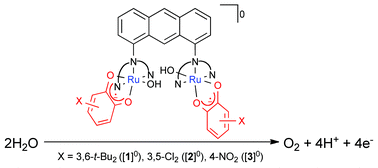Substituents dependent capability of bis(ruthenium-dioxolene-terpyridine) complexes toward water oxidation†
Abstract
The bridging

- This article is part of the themed collection: New Talent: Asia
* Corresponding authors
a
Department of Chemistry, College of Science, Rikkyo University, 3-34-1 Nishi-Ikebukuro, Toshima, Tokyo, Japan
E-mail:
twada@rikkyo.ac.jp
Fax: 81-3-3985-2373
Tel: 81-3-3985-2373
b
Chemistry Department, Brookhaven National Laboratory, Upton, NY, USA
E-mail:
fujita@bnl.gov, mukerma@bnl.gov
Fax: 1-631-344-5815
Tel: 1-631-344-4356
c
Department of Life and Coordination Molecular Science, Institute for Molecular Science, 5-1, Higashiyama, Myodaiji, Okazaki, Aichi, Japan
E-mail:
ktanaka@ims.ac.jp
Fax: 81-564-59-5582
Tel: 81-564-59-5580
The bridging

 Please wait while we load your content...
Something went wrong. Try again?
Please wait while we load your content...
Something went wrong. Try again?
T. Wada, J. T. Muckerman, E. Fujita and K. Tanaka, Dalton Trans., 2011, 40, 2225 DOI: 10.1039/C0DT00977F
To request permission to reproduce material from this article, please go to the Copyright Clearance Center request page.
If you are an author contributing to an RSC publication, you do not need to request permission provided correct acknowledgement is given.
If you are the author of this article, you do not need to request permission to reproduce figures and diagrams provided correct acknowledgement is given. If you want to reproduce the whole article in a third-party publication (excluding your thesis/dissertation for which permission is not required) please go to the Copyright Clearance Center request page.
Read more about how to correctly acknowledge RSC content.
 Fetching data from CrossRef.
Fetching data from CrossRef.
This may take some time to load.
Loading related content
